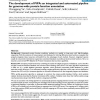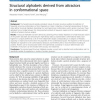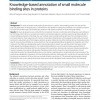153 search results - page 6 / 31 » Clustering the annotation space of proteins |
BMCBI
2008
13 years 7 months ago
2008
Background: Automated protein function prediction methods are needed to keep pace with high-throughput sequencing. With the existence of many programs and databases for inferring ...
BMCBI
2010
13 years 7 months ago
2010
Background: The hierarchical and partially redundant nature of protein structures justifies the definition of frequently occurring conformations of short fragments as `states'...
BMCBI
2007
13 years 7 months ago
2007
Background: Most methods for predicting functional sites in protein 3D structures, rely on information on related proteins and cannot be applied to proteins with no known relative...
BMCBI
2006
13 years 7 months ago
2006
Background: Ensemble attribute profile clustering is a novel, text-based strategy for analyzing a userdefined list of genes and/or proteins. The strategy exploits annotation data ...
BMCBI
2010
13 years 7 months ago
2010
Background: The study of protein-small molecule interactions is vital for understanding protein function and for practical applications in drug discovery. To benefit from the rapi...



